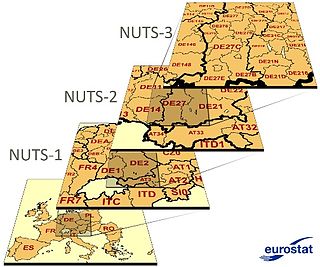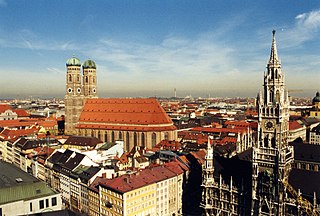
A metropolitan area or metro is a region consisting of a densely populated urban agglomeration and its surrounding territories sharing industries, commercial areas, transport network, infrastructures and housing. A metropolitan area usually comprises multiple principal cities, jurisdictions and municipalities: neighborhoods, townships, boroughs, cities, towns, exurbs, suburbs, counties, districts and even states and nations in areas like the eurodistricts. As social, economic and political institutions have changed, metropolitan areas have become key economic and political regions.

The Upper Silesian metropolitan area is a metropolitan area in southern Poland and northeastern Czech Republic, centered on the cities of Katowice and Ostrava in Silesia and has around 5 million inhabitants. Located in the three administrative units : mainly Silesian Voivodeship, a small western part of Lesser Poland Voivodeship and a small east part of Moravian-Silesian Region.

The London metropolitan area is the metropolitan area of London, England. It has several definitions, including the London Travel to Work Area, and usually consists of the London urban area, settlements that share London's infrastructure, and places from which it is practicable to commute to work in London. It is also known as the London commuter belt, or Southeast metropolitan area.

Nomenclature of Territorial Units for Statistics or NUTS is a geocode standard for referencing the administrative divisions of countries for statistical purposes. The standard, adopted in 2003, is developed and regulated by the European Union, and thus only covers the EU member states in detail. The Nomenclature of Territorial Units for Statistics is instrumental in the European Union's Structural Funds and Cohesion Fund delivery mechanisms and for locating the area where goods and services subject to European public procurement legislation are to be delivered.

Eurostat is a Directorate-General of the European Commission located in the Kirchberg quarter of Luxembourg City, Luxembourg. Eurostat's main responsibilities are to provide statistical information to the institutions of the European Union (EU) and to promote the harmonisation of statistical methods across its member states and candidates for accession as well as EFTA countries. The organisations in the different countries that cooperate with Eurostat are summarised under the concept of the European Statistical System.

The Hamburg Metropolitan Region is a metropolitan area centred around the city of Hamburg in northern Germany, consisting of eight districts in the federal state of Lower Saxony, six districts in the state of Schleswig-Holstein and two districts in the state of Mecklenburg-Vorpommern along with the city-state of Hamburg itself. It covers an area of roughly 26,000 square kilometres (10,000 sq mi) and is home to more than 5.1 million inhabitants.
Statistics in the European Union are collected by Eurostat.

The Madrid metropolitan area is a monocentric metropolitan area in the centre of the Iberian peninsula, around the municipality of Madrid, Spain. It is not related to any sort of administrative delimitation, and thus, its limits are ambiguous.

Oradea metropolitan area is a metropolitan area located in Western Romania, in the County of Bihor, Crișana, Transylvania, Romania and was founded on 9 May 2005.

The Katowice urban area, also known as the Upper Silesian urban area, is an urban area/conurbation in southern Poland, centered on Katowice. It is located in the Silesian Voivodeship and in a small part of the Lesser Poland Voivodeship. The Katowice urban area is the largest urban area in Poland and one of the largest in the European Union.

The Barcelona urban area is an urban area in Catalonia (Spain) centered on the city of Barcelona and located less than 100 km south of the border with France. With a population of over 5 million, it is one of the largest urban areas in Europe.

The Cologne Bonn Region is a metropolitan area in North Rhine-Westphalia (NRW), Germany, covering the cities of Cologne, Bonn and Leverkusen, as well as the districts of Rheinisch-Bergischer Kreis, Oberbergischer Kreis, Rhein-Erft-Kreis and Rhein-Sieg-Kreis. The region covers an area of 3,839 km² with 3.13 million inhabitants. The city centres of Cologne and Bonn are 24 kilometres apart as the crow flies. At the outer city limits, there are only 8 kilometres between Cologne-Libur and Bonn-Geislar.

The Rhine-Main Metropolitan Region, often simply referred to as Frankfurt Rhine-Main, Frankfurt Rhine-Main area or Rhine-Main area, is the second-largest metropolitan region in Germany after Rhine-Ruhr, with a total population exceeding 5.8 million. The metropolitan region is located in the central-western part of Germany, and stretches over parts of three German states: Hesse, Rhineland-Palatinate, and Bavaria. The largest cities in the region are Frankfurt am Main, Wiesbaden, Mainz, Darmstadt, Offenbach, Worms, Hanau, and Aschaffenburg.

In urban planning, a historic core city or central city is the municipality with the largest 1940 population in the present metropolitan area. This term was retired by the US census bureau and replaced by the term principal city, which can include historic core cities and post-WWII cities. Metropolitan areas were no longer considered monocentric, but polycentric due to suburbanization of employment. A historic core city is not to be confused with the core of a metropolitan area which is defined as an urban area with a population of over 50,000 by the US census bureau.

The Munich Metropolitan Region is one of eleven metropolitan regions in Germany, consisting of the agglomeration areas of Munich, Augsburg, Ingolstadt, Landshut, Rosenheim and Landsberg am Lech. It is Germany's fifth most populous metropolitan region after the Rhine-Ruhr Metropolitan-Region, the Frankfurt Rhine-Main-Region, the Berlin-Brandenburg Metropolitan-Region and the Stuttgart Metropolitan-Region.

An aire d'attraction d'une ville is a statistical area used by France's national statistics office INSEE since 2020, officially translated as functional area in English by INSEE, which consists of a densely populated urban agglomeration and the surrounding exurbs, towns and intervening rural areas that are socioeconomically tied to the central urban agglomeration, as measured by commuting patterns. INSEE's functional area (AAV) is therefore akin to what is most often called metropolitan area in English.

The Vilnius urban area is the urban area of Vilnius. The urban area covers several municipalities in the Vilnius County.















